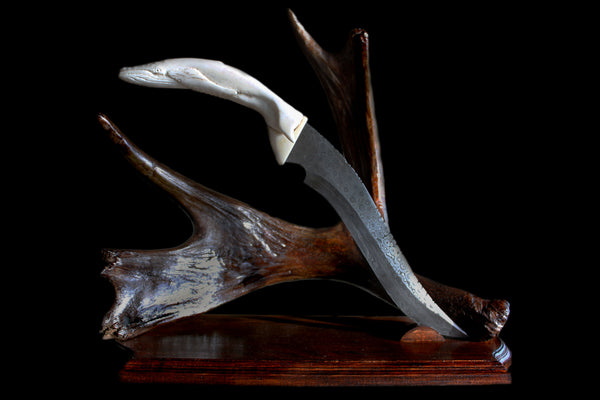Some people collect stamps. Some people collect commemorative pins.
I collect hobbies.
Every year I add two or three new hobbies to my collection. Most of them are trades like leathercraft, woodworking, or Photoshopping.
I hit a hobby bonanza a few years back when I was in school to become a Doctor of Physical Therapy (my day job). I spent a summer in beautiful Fairbanks, Alaska, providing therapy to the local Alaskan native population. As I grew closer to these wonderful people, I couldn’t help picking up a few of their traditional crafts.
This unleashed a flurry of creative energy that inspired the projects in this post.
Although none of these creations are “cosplay” in the strictest sense, they demonstrate several ancient art forms which could be useful in creating an Avatar Water Tribe costume or any other ancient or indigenous character.
Plus, I believe that if you are trying to express a traditional character, you can indescribably deepen the believably of your costume by constructing it with traditional methods and materials.
After all, why settle for being realistic, when you could be real?
The Whale Knife

My father collects weapons—particularly blades—so whenever I travel to an exotic location I try to bring back something for his collection.
Most traditional Alaskan weapons are of the primitive variety: clubs, atlatls, etc. I eventually created a jawbone club for my dad (I’ll get to that later), but I still wanted to give some kind of knife or sword.
Since the only metal ancient Alaskans had was that which washed up on the beaches after being carried on ocean currents from China and Japan, bladed weapons were necessarily limited. There’s the classic Ulu of course, which has a blade that is sometimes knapped from slate or obsidian, but Ulus were used almost exclusively by women for skinning animals and preparing meals.

Traditional designs for the Alaskan Ulu or “women’s knife.” Image from: Oldjimbo.com.
I wanted a more macho alternative, so I decided to craft a less traditional blade.
I found my inspiration in a Fairbanks gift shop. Selling for $300 was the following knife:

I liked the basic idea of this knife. The whale design was elegant and captured a lot of Alaskan flair.
I felt like it only scratched the surface of the potential for a whale knife though. I could do better.
I carved my knife from Alaskan moose and caribou antlers. The whale was greatly enlarged over the gift shop design so that it occupied the whole hilt. This created a very comfortable grip, as the shape of the whale complements the shape of a closed hand nicely. The whale’s flukes also served as a natural and aesthetic cross-guard.

The blade was purchased online, since I don’t have a forge of my own…yet. It is Damascus steel with a”raindrop” pattern that adds to the overall aquatic feeling of the piece.
The ocean theme was further enhanced by the gentle S-curve of the blade, which creates a sense of movement and naturally flows into the shape of the whale.
Finally, the moose-antler display was constructed to complete the movement of the piece—as if the whale were breaching out of a great breaking wave. In its display, the knife appears to float magically as it is suspended by carefully positioning the tip of the blade between the base of the antler and a wooden strut.

All in all, this blade turned out to be a beautiful, yet very authentic-feeling piece of Alaskan art.
Fur, Beads and Ivory
My next projects grew out of friendships I made with local artisans—a furrier, a Native Alaskan flat beading expert and some fossil ivory collectors.
The furs were from primarily from Alaskan animals, caught by local trappers. In keeping with the native tradition to use every part of the animal (Ancient Alaskans would even use the fibrous sac around a moose’s heart as a watertight pouch), I crafted with the scraps of my furrier friend’s larger creations.
Native American flat beading may be an unfamiliar term, but you’d probably know it if you saw it:

Native American moccasins decorated with flatbeading. Image from: Crazy cow trading post.
You’ve seen that before, right?
These designs are created by first putting each row of beads on its own string and then sewing the strings into place. Creating very intricate designs requires a lot of patience and practice, but the basic principle is simple, and I was able to learn quickly enough to create some half-way decent art after only a couple of tries.
Finally, ivory is a beautiful medium and is a joy to carve, but of course I would never wish to support the poaching of elephants, walruses, or rhinoceroses. In the United States ,it is illegal to purchase or possess rough ivory from these sources unless you are a Native American.
Fossil ivory, however, is another story. The far northern parts of the world like Alaska and Siberia are still thawing out of the last ice age, and new tusks melt out of the ice every day. Many of these are broken and separated from the rest of the mammoth or walrus skeleton, and are not of great scientific value.
They are very valuable to crafters like me though! Mammoth ivory is not only cooler than modern ivory (I mean, think about it…mammoth ivory!), it has a beautiful grain in cross-section, and is often stained over thousands of years into all sorts of cool colors.
For example, check out this creation of mine, which features a central piece of mammoth ivory with a beautiful weather-stained pattern.

Hair ornament featuring fossil mammoth ivory, Native American flat beading, and Alaskan beaver fur.
The natural shape of the ivory lent itself well to becoming a hair-pin. Curved pieces of ivory like this are called “bark.”
In this particular piece, I surrounded the ivory with fur from the face of a beaver. To swim in arctic ponds and rivers, beavers need very thick fur and—once you shave the guard hairs off—their undercoat is unbelievably soft.
The piece is decorated with spiraling flat beading patterns and secured with a pin of bone.

Beaded spirals decorate the piece and help secure the bone pin.
My next creation was very similar—mammoth ivory in the center, with flat beading and fur around it—except this time the ivory was flat, which lent itself to a very different design.

The fur used here is from an arctic wolf. Arctic wolves are the only species of wolf which are not endangered (they’re not even threatened). This is likely because their habitat is so far north that it overlaps very little with humanity.
I made a third hair ornament from a cross-sectional piece of fossil mammoth tusk.

This hair comb demonstrates some of the excellent carving potential that ivory has. I use a dremmel tool and a jeweler’s saw in my bone and ivory carvings. These may not be the most traditional tools, but my native friends used them too, so I felt comfortable following suit.
I carved the final piece into the shape of wild columbine blossoms, with Swarovski crystal set in the center of each.
The final accessory in this set was a bracelet featuring a piece of walrus ivory into which I carved the shape of a true Alaskan native—the bowhead whale.

In this piece, the whale is flanked by leather straps with a beaded repeating arrow design. Simple, angular designs like these are common in ancient art.
The Story Club
The last member of the Alaskan collection was another weapon for my dad: a moose jawbone club.

This combined several martial and maritime traditions.
Skinny on one end, heavy on the other, jawbones have been used as clubs for thousands of years. The Bible even identifies such a club as the legendary Samson’s weapon of choice:
- “And Samson said, With the jawbone of an ass, heaps upon heaps, with the jaw of an ass have I slain a thousand men.” (Judges 15:16)
The jawbone club may have influenced other native club designs as well. Some clubs carved from wood feature a ball set between two prongs on a curved shaft—a design that appears to have grown out of the basic jawbone shape.

These traditional war club designs have a shape reminiscent of a jawbone, in some cases with a stone set between the “condyles” of the jaw.
My father’s club, however, was not made for war.
One of my Alaskan native friends introduced me to the local concept of the “story knife.” According to her, this was a ceremonial weapon which belonged to a tribal elder, and which was decorated with images of significant events from his or her life. In a culture with no written language, these story knives served as both a pictorial diary and also a way to remember one’s ancestors when they had passed on.
Now, story knives were not always knives, per se. In fact, the examples that my friend showed me were all spears. So, I decided that I would make my father a story club.
To decorate the club I relied on the old maritime tradition of scrimshaw.
Scrimshaw is most commonly performed on ivory or whale teeth. Bone is less ideal, as it tends to be more porous and have more cracks, but it can also be made to work.
The basic technique for scrimshaw involves polishing the ivory or bone to a very smooth surface. A design is then lightly scratched into the surface with a small metal tool like a pin. The artist then applies india ink to the picture and wipes it off. Provided the original polish was good enough, the ink will remain only in the etched areas, and the picture will begin to appear.
For my father’s club, I put pictures from his life that had to do with nature on one side (for the sake of display), and more geometric, modern scenes and symbols on the back.

The club was further decorated with black leather lace. I drilled holes through the bone and applied a round braid stitch to the underpart of the jaw to create a border between the front and back scenes.
Leather lace and fur were also used to add texture to the handle and create decorative tassels.

Summary
As I said at the beginning, although these creations were not “cosplay” in the strictest sense, they very well could have been.
I could easily imagine an Avatar Water Tribe chieftain wielding the ceremonial whale knife, or the story club and the costume of any tribal princess would be enhanced by the accessories in this post.
What’s more, the skills I learned in Alaska have been used in many other projects. Bone carving comes up again in my Avatar betrothal necklace, and extra fur from my Alaskan friend trims my Legend of Zelda Quiver.
In the future, I’ll add some more “how to” posts about the techniques I used to create these projects. For now, though, I hope you gained a little inspiration from my projects just as I was inspired by the great Alaskan landscape and the incredible people who have long populated it.







